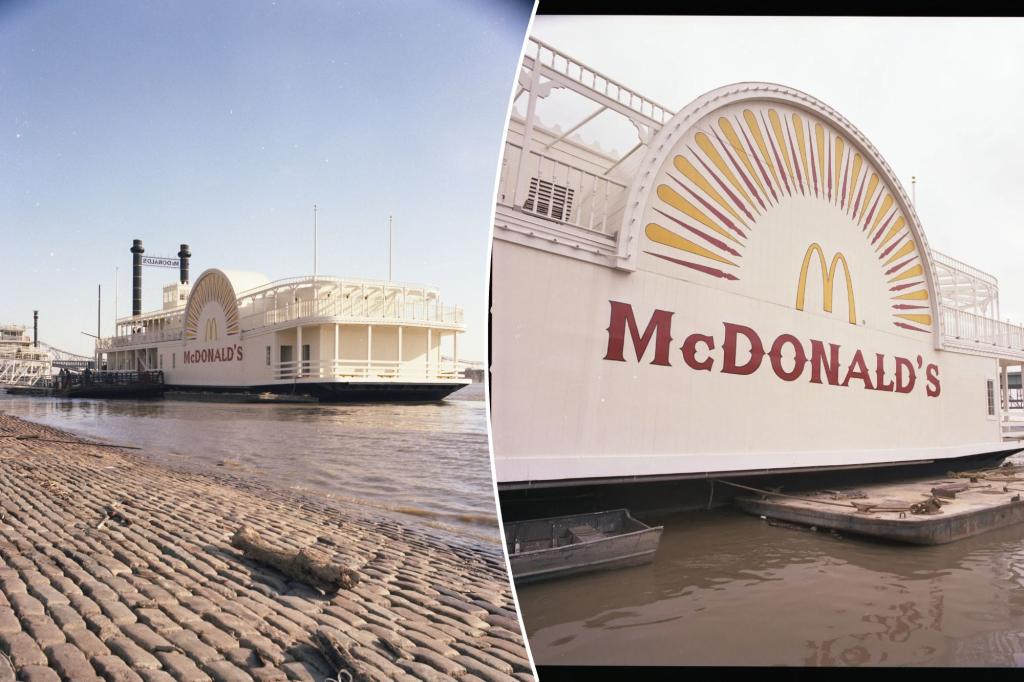A famed sunken ship is finally resurfacing.
Photos from the peak era of the world’s first-ever floating McDonald’s are bringing the culinary curiosity back into the spotlight.
On March 11, 1980, the floating Golden Arches officially opened for business in St. Louis, Missouri, just south of the iconic Gateway Arch.
Built on a repurposed cement barge, the 702-ton boat was designed to resemble a 19th-century riverboat, with room for 134 indoor diners and an additional 200 on its open-air decks.
The fast food chain initially hoped to open a location in the museum under the Gateway Arch, but as the St. Louis Post-Dispatch reported, the government didn’t want to open the space to a private business.
When Samuel Haynes, McDonald’s real estate manager at the time, had the idea to put the restaurant on a riverboat, it was met with opposition from the St. Louis Board of Aldermen, who feared that the floating Golden Arch would compete with the Gateway Arch.
But McDonald’s executives believed in the idea, and a 25-year lease for the franchise was signed in February 1979. The McBoat ended up generating $100,000 in tax revenue annually.
“We have nothing like this in the whole world,” Pat Flynn, a senior vice president for McDonald’s at the time, told the St. Louis Post-Dispatch.
“If we can find a large group of people together, we should be able to feed them, The Arch draws more than 3 million people a year,” Haynes added.
“Then we looked down at the river and saw a lot of people taking advantage of it, so we thought there was no reason why a company as adaptable and progressive as McDonald’s couldn’t do it.”
Locals also were skeptical that it would cheapen the Missouri waterfront, but they came around to it eventually, and many have commented their fond memories on a Facebook post reminiscing about the floating McDonald’s.
“I thought at first McDonald’s would make the riverfront look cheap, but it was pretty cool for a while,” someone admitted.
“This was my favorite place growing up. So many good memories feeding the fish all my french fries,” one person quipped.
“That was so much fun as a kid!” another exclaimed.
“This was me and my grandpa’s spot. We used to go up in the arch and then go to McDonald’s on the boat after,” one Reddit user remembered. “Thanks for the good memory today. Needed it.”
“Took my kids up river in our old boat, tied off, climbed over the rails for lunch once. They still talk about it!” someone shared.
In fact, it become so loved by locals that this year, the Gateway Arch put out an April Fool’s press release joking that the McDonald’s floating restaurant would be reopening.
Despite the early concerns, the floating Mickey D’s became a staple for many who grew up and lived in St. Louis as well as tourists who didn’t want to be land-locked while eating their Big Macs.
The riverboat in St. Louis closed in 2000 due to the high costs and difficulties of maintaining it as a floating restaurant — especially after the renovations needed due to the Great Flood of 1993, according to the St. Louis Post-Dispatch.
Now, all that remains of the once beloved floating McDonald’s are historical photographs, which have been captured both in black and white and in color.
Based on the photos, the only clear link to the modern McDonald’s that everyone knows and loves is the the iconic red and yellow coloring.
After the floating McDonald’s officially shut down on November 6, 2000, it was never seen on the St. Louis riverfront again.
Though the St. Louis ship was the first floating McDonald’s in the world, there was a second one built for the 1986 World Expo in Vancouver — and it very recently capsized.
The McBarge, also called the Friendship 500, starting sinking in the Fraser River at the end of March, the Vancouver Sun reported.
The abandoned McDonald’s barge sat vacant for five years on False Creek while McDonald’s fought to keep it open to no avail. In 1991, the city forced the company to move the McBarge.
Now, the second and last floating McDonald’s has capsized and is sinking, joining the St. Louis boat in extinction.
Read the full article here

